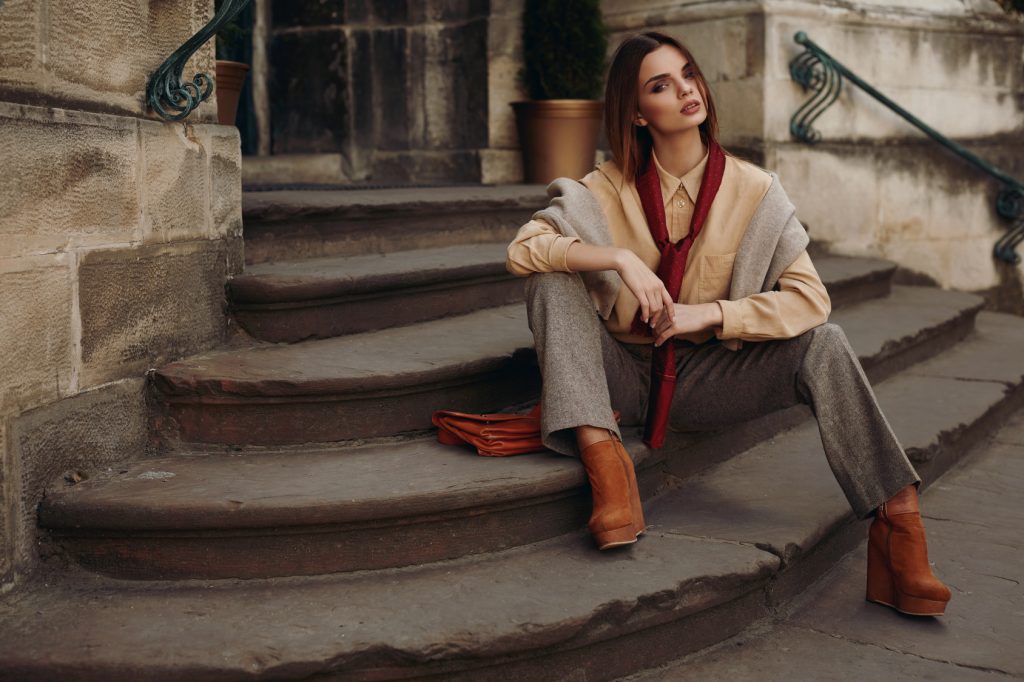
Just when we begin taking outdoor coffee dates for granted, it happens.
Summer is almost out and autumn has started to kick in. With Eid al-Adha in horizon, and the change of season in many places, there’s nothing like the feel of digging out an old, treasured sweater and draping it against your skin on a cold night. Falling leaves usher in the season of cozy knits, cashmere and wool.
It is a nostalgic time when we settle back into the old standbys–leather boots and gloves, scarves (made with love) that seem to go on for miles, and bundle-worthy coats.
Sometimes simple is the best solution. Just ask Fatima Rafiy, Noor DIzars innovative Belgian designer who stunned audiences and judges at Paris Fashion Week in 2010 with her comfortable headscarves. Some of these scarves, such as the style that featured a built-in, stay-put band, made an impression with a leather aviator-inspired top that was fierce and lux, all leather and fur. It conjured images of a strong, proud lioness high on a rocky cliffside.
Interestingly, Muslim women were not the only buyers post-show. In fact, one gentleman purchased the piece as a fashion accessory for his motorcycle.
One of the most eye-catching things about Rafiys line is her pin-free hijab technique that suits the many non-fussers of the world. Included among this group is is Maryam Yusof of the Aquila Style blog. Aside from the hijab, Yusof gave a shout-out to Noor DIzars crocheted cap and shawl duo when calling attention to a collection of fuss-free hijabs.
The combo is certainly beautiful, and perfection for an autumn stroll. It has a European feel and would suit just about any woman. The cap and scarf can be worn together or separately, with or without a headscarf. It’s feminine and it’s fun, mirroring Rafiys personal mantra when it comes to fashion design. Shell tell you its very important to be innovative.
Case-in-point: here is a refer to the websites section on hijabology. This is essentially a field guide that suggests how to wear and stylishly combine types of scarves. It offers readers step-by-step guides on wraps like the Imsar (supposedly quite easy to wear and also sunglass-proof), Juna, Izir, Wrappa, Wrappa 2, Isi Sport/Irin and Tuban.
”I don’t get my inspiration from one certain thing but from all kinds of different things around me,” says Rafiy. ”Sometimes from traveling, sometimes from architecture, other times from fabrics with animal prints.
Being able to create my own style and to do what I’ve always dreamed about doing is what I love the most, she says. The basic hijab is always made of silk. This winter I will definitely focus on fur again…lace, velvet, silk and maybe leather.
Sabika Makhdoom, who creates clothes for Sabika Seattle, is another designer looking to integrate soft fabrics and a feminine aesthetic to bolster her upcoming 2013 fall and winter collection. This past summer, Makhdoom showed her collection at a charity show called Relief on the Runway in New York during Septembers Fashion Week. Now she is holding down the fort in Seattle and also working on a Look Book.
”I want to be fashionable. I want to be feminine. But I still want to meet all the modest requirements,” says Makhdoom. ”This fall and winter Im using a lot of knit, and just a bit of lace.” Knit, or Americas favorite fabric as she likes to call it, is a shape shifter that lends itself to lots of comfort and easy style. Hence, she is experimenting with crochet on necklines, trendy layers and high-low hems. Makhdoom is also partial to silk (despite its top-drawer price) as it is a glamorous workhorse for all seasons.
”I personally like natural fabrics so I tend to use more silk, she says. Its a bit harder to work with because its more expensive, but I like it because its breathable and can be warm in the winter and cool in the summer.”
Not one to be boxed-in, Rafiy remains versatile in her approach to outfitting women and men around the world. As she points out: I have a lot of different designs in mind and each and every one of those can be worn in many different ways,” Rafiy said.






